Staten Island
When they settled Manhattan Island, the Dutch sailed past a larger island that they named Staaten Eylandt. From 1639 attempts were made to settle Staaten Eylandt, but the local Indians destroyed each settlement. In 1661 the Dutch managed to set up a permanent settlement called Oude Dorp (Old Village). Old Town Station on the Staten Island Railway is close to the site of this settlement. The Dutch ceded Staten Island to the British in 1667 under the Treaty of Breda. During the Revolutionary War, British forces used Staten Island as a base to attack New York. Modern Staten Island has a rather split personality. Close to the ferry and along the Staten Island Railway are commuter areas, while other parts of the island are surprisingly rural for a Borough of New York City. It is the largest Borough by area, but the smallest in terms of its population of around half a million people.
St George
The neighbourhood around the ferry terminal is not named after the dragon-slaying saint, but after George Law who bought up the land along the waterfront. Legend has it that Law only agreed to part with the land for the ferry terminal in return for being ‘canonised’. The sprawl of St George is a sign of the impact that the that the ferry has made. St George went into decline after the 1964 opening of the Verrazano Narrows Bridge made commuting possible from the more rural areas of the island. The resultant pause in development left the area with several old buildings which have now been designated St. George Historic District.
Governor's House, Snug Harbor
The full name of Snug Harbor on the north coast of Staten Island is Sailors’ Snug Harbor has an unusual history. Captain Robert Richard Randall was the son of a Privateer who had amassed considerable wealth. Robert took over his father’s fleet when he retired and inherited his wealth when he died. Robert established a country estate in Manhattan between 5th Avenue and Broadway just north of Washington Square. Sailing had been his life so hen he died in 1801, Robert’s will directed that the an institution should be built on the Manhattan estate to care for ‘aged, decrepit and worn-out’ seamen. The children of Randall’s half-brother attempted unsuccessfully to challenge the will, delaying the institution by many years. By that time the land around the Manhattan Estate had been developed so the Trustees decided that the institute should be built on land left by Randall in Staten Island. The first former sailors moved in to Sailors’ Snug Harbor in 1833, where they were all called ‘Captain’ by staff regardless of their rank in their days at sea. The operation of the institute was overseen by a Governor, who lived in the house in this picture. By the 1950s Sailors’ Snug Harbor was in financial difficulty with its fine buildings in serious decay. In the 1960s the Trustees drew up plans to redevelop the site but their plans were successfully opposed by the New York City Landmarks Commission. In the 1970s the Trustees sold the site to the City of New York who restored the buildings and reopened them as the Snug Harbor Cultural Center.
Click on Minimap to navigate
Home > US States > Midatlantic USA > New York > New York City >
Stephens-Black House & General Store, Historic Richmond Town, Staten Island
The town of Richmond was founded in the late 17th century and in 1728 it became the island’s seat of government. After the island was incorporated into New York City in 1898 the town became a backwater. Over 30 buildings have been preserved as an open air museum called Historic Richmond Town. Some of the buildings were built where they stand while others have been moved from other locations in Staten Island and the oldest date back to the 17th century. This picture shows the 1837 Stephens-Black House with at its rear the General Store built around 1839. Most of the General Store was demolished in the 1940s so the current building is largely a reconstruction. The interior of the house has been restored to how it would have looked around 1860 while the General Store is furnished as at the end of the 19th century. Both buildings are open to the public. An example of a building that has been moved to the museum is the Guyon-Lake-Tysen House which was built around 1740 by Joseph Guyon, a farmer of Huguenot descent. The Dutch Colonial style building originally stood on his farm near near New Dorp Beach but it was moved to Historic Richmond Town in 1962. The interior wood panelling of the house is very well preserved. Click Tab 2 to see the Guyon-Lake-Tysen House.
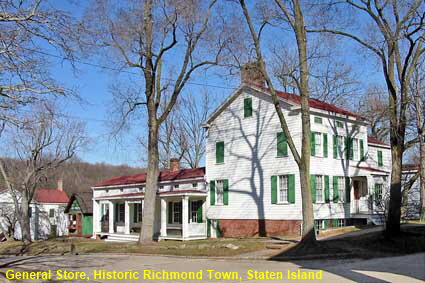
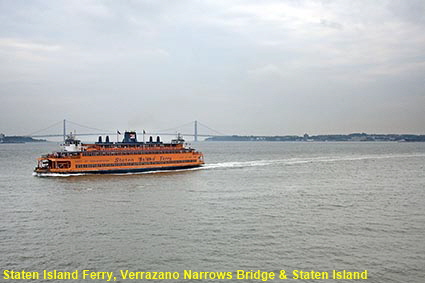
Staten Island Ferry, Verrazano Narrows Bridge & Staten Island
The best free attraction in New York by far is the Staten Island Ferry. It takes you from Lower Manhattan on an 8.3 kilometre (5.2 mile) journey past the Statue of Liberty to St. George on Staten Island. The first steam ferry service to Staten Island started in 1817 using the ‘Nautilus’ owned by the Richmond Turnpike Company. During the Civil War the ferry company was sold to the Staten Island Railway. In the early 20th century following a fatal accident, New York City took control of the ferry service and they continue to run it today. A 50 cent fee to travel from Manhattan to Staten Island was abolished in 1997. At peak times ferries run every 15 minutes. The Verrazano Narrows Bridge in the background links Staten Island to Long Island. It is named in honour of 16th-century Florentine explorer Giovanni da Verrazzano although that honour did not extend to spelling his name correctly. Built in 1964 it has a span of 1,298 metres (4,260 feet). When it opened it was the longest span in the world and it remains the longest suspension bridge in the Americas. Click Tab 2 to see a closer view of the Verrazano Narrows Bridge.
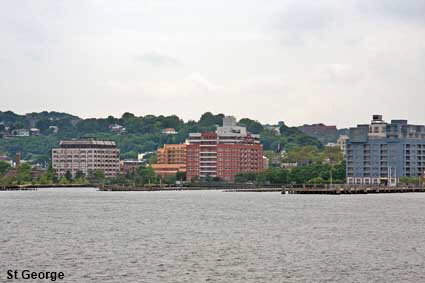
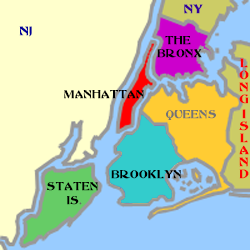
DLU170607


To move forwards or backwards through the New York City trail click the arrows above, or select your next destination on the Minimap.
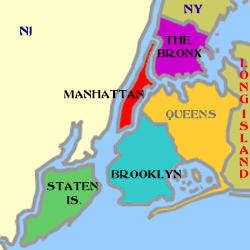
Chinese Scholar's Garden, Snug Harbor
Staten Island Botanical Garden was founded in 1977 on land adjacent to Sailors’ Snug Harbor. In 1999, after 18 months of work both in China and at the Botanical Garden, the Chinese Scholar’s Garden was opened to the public. It is a compilation of different gardens of the Ming Dynasty (1368-1644) from across China and is one of only two authentic scholar’s gardens in the USA. The Botanical Garden merged with Snug Harbor Cultural Center in 2008 under the innovative and punchy name of the ‘Snug Harbor Cultural Center & Botanical Garden’. Click Tab 2 to see the interior of one of the eight Pavilions in the Chinese Scholar's Garden.
Garibaldi-Meucci Museum, 420 Tompkins Avenue
Antonio Meucci was born in a suburb of Florence in 1808. He studied chemical and mechanical engineering but had to give up his studies due to lack of funds. In 1835 he and his wife emigrated to Cuba where he made money as an inventor. In 1850 he moved to the USA and settled on Staten Island. He used the money he had made in Cuba to set up a a tallow candle factory. He was a friend of General Giuseppe Garibaldi who arrived in New York in 1850 after participating in the unsuccessful First Italian War of Independence. Meucci rented his house on Staten Island to Garibaldi until he left for Britain at the end of 1853. Garibaldi returned to Italy in 1860 and is regarded as a key figure in the unification of the country. Meantime Meucci continued his work as in inventor. In 1854 his wife became disabled with arthritis, and in 1856 he developed a means of transmitting voice along wires which he installed between his wife’s bedroom and his basement laboratory. He continued to work on his invention but in 1861 he was bankrupted by some rather dubious debts and in 1870 he was injured by a boiler explosion aboard a Staten Island ferry. He applied for a patent caveat for ‘Sound Telegraphs’ in 1871, but his invention was poorly defined possibly because of his health and finance problems. This left the door open for Alexander Graham Bell to secure a patent for the ‘electromagnetic transmission of vocal sound by undulatory electric current’ in 1876. Had Meucci properly defined his invention then he rather than Bell might be regarded as the inventor of the telephone. The house that Meucci owned on Staten Island is now open to the public as the Garibaldi-Meucci Museum
Billopp House, Conference House Park
Christopher Billopp, a former Captain in the Royal Navy, arrived in the Colonies in 1674. He was granted a land patent on 377 hectares (932 acres) of land at the southern tip of Staten Island. On this land he built a stone manor house that he named ‘Bentley Manor’, after a ship that he had commanded. The house was inherited by his great grandson Colonel Christopher Billopp, who took the Loyalist side during the American Revolution. On September 11, 1776 the house was the centre of an attempt to end the Revolutionary War. Staten Island was held by the British while Perth Amboy on the New Jersey side was held by the Continental Army. Lord Howe, commander in chief of the British forces, arranged to meet representatives of the Continental Congress for a peace conference at the house. Benjamin Franklin, John Adams, and Edward Rutledge rowed over for the meeting which lasted for three hours. It ended without agreement and the war continued until 1783. At the end of the war the house was confiscated by the State of New York and the Billopp family moved to Canada. By the 1880s the house had been abandoned and a bill was introduced in the New York State legislature to acquire it for a museum. The bill failed as did several other attempts to acquire it. In 1926 a real estate company that had acquired the land gave the house to the City of New York. Local preservationists took on the task of restoring the house to look as it would have at the time of the peace conference. The Conference House is open for guided tours certain days of the week in season. Unfortunately it was not open on the day that we visited.
Alice Austen House, 2 Hylan Boulevard
This site is full of photographs (probably around 2,500) so it is great to have an entry about photography on 50 plus DC. Born to a well off family in 1866, Alice Austin was introduced to photography at the age of ten when her uncle, Danish sea captain Oswald Müller, came home with a camera. He demonstrated it to the family and Alice became fascinated by it. When Müller returned to sea he gave Alice permission to use the camera. Another uncle called Peter, a chemist, showed her how to develop the glass plates and make prints from them. Her uncles built a small darkroom and by the time she have reached the age of 18 she was an experienced and talented photographer. She took pictures of daily life in Staten island then in the 1890s she began to take her heavy plate camera further afield to upstate New York and other states. Alice Austen lived her life at the family home called ‘Clear Comfort’, from 1917 sharing it with Gertrude Tate who became her life long companion. She lived off income from her inheritance until the Wall Street crash wiped it out. In 1945 she lost the house and in 1950 she entered the poor house. Publication in 1951 of some of her 8,000 photographs raised enough money for her to move to a nursing home, where she died in 1952. Her house has become the Alice Austin House, a museum of her life and works. Click Tab 2 to see the Parlor and Tab 3to see a plate camera similar to the one that she used.
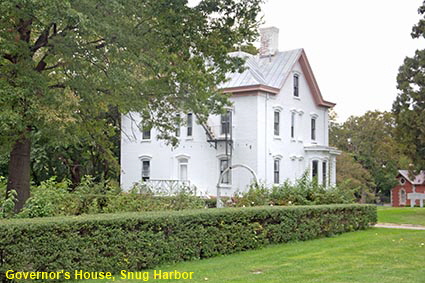
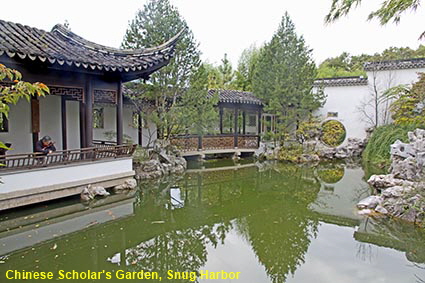
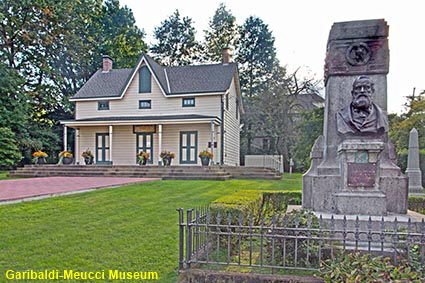
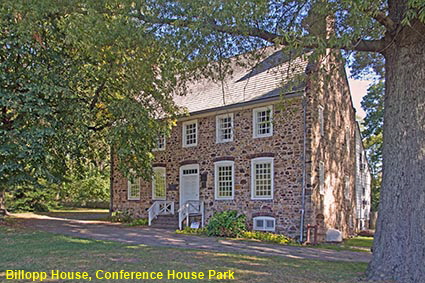
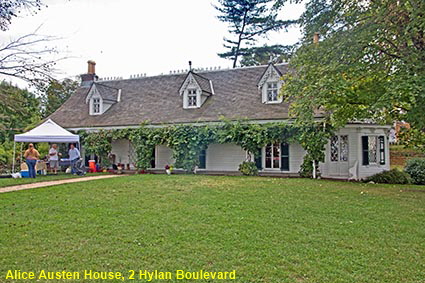
© Mike Elsden 1981 - 2025
The contents of this page may not be reproduced in full or in part without permission